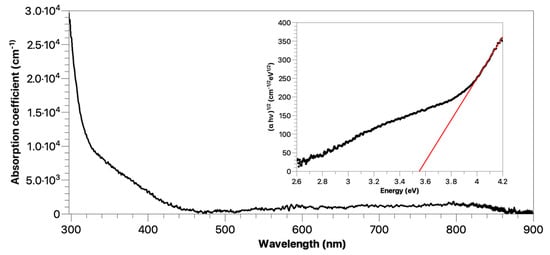Synthesis of High Quality Transparent Nanocrystalline Diamond Films on Glass Substrates Using a Distributed Antenna Array Microwave System
Abstract
1. Introduction
2. Materials and Methods
3. Results and Discussion
4. Conclusions
Author Contributions
Funding
Institutional Review Board Statement
Informed Consent Statement
Data Availability Statement
Acknowledgments
Conflicts of Interest
References
- Srikanth, V.V.S.S. Review of advances in diamond thin film synthesis. Proc. Inst. Mech. Eng. Part C J. Mech. Eng. Sci. 2012, 226, 303–318. [Google Scholar] [CrossRef]
- Kawano, Y.; Chiba, S.; Inoue, A. Application of diamond window for infrared laser diagnostics in a tokamak device. Rev. Sci. Instrum. 2004, 75, 279–280. [Google Scholar] [CrossRef]
- Mildren, R.P.; Butler, J.E.; Rabeau, J.R. CVD-diamond external cavity Raman laser at 573 nm. Opt. Express 2008, 16, 18950. [Google Scholar] [CrossRef] [PubMed]
- Martineau, P.M.; Lawson, S.C.; Taylor, A.J.; Quinn, S.J.; Evans, D.J.F.; Crowder, M.J. Identification of Synthetic Diamond Grown Using Chemical Vapor Deposition (CVD). Gems Gemol. 2004, 40, 2–25. [Google Scholar] [CrossRef]
- Ficeka, M.; Bogdanowicza, R.; Rylb, J. Nanocrystalline CVD Diamond Coatings on Fused Silica Optical Fibres: Optical Properties Study. Acta Phys. Pol. A 2015, 127, 868–873. [Google Scholar] [CrossRef]
- Simões, R.; Neto, V.F. Nanodiamond Coated Glass as a Protective Layer in Solar Cells. Mater. Today Proc. 2015, 2, 230–235. [Google Scholar] [CrossRef]
- Veerasamy, V.S.; Luten, H.A.; Petrmichl, R.H.; Thomsen, S.V. Diamond-like amorphous carbon coatings for large areas of glass. Thin Solid Film. 2003, 442, 1–10. [Google Scholar] [CrossRef]
- Ko, H.-W.; Chen, C.K.; Liu, C.-H.J. Optical scattering of diamond films. Diam. Relat. Mater. 1996, 5, 861–865. [Google Scholar] [CrossRef]
- Williams, O.A.; Daenen, M.; D’Haen, J.; Haenen, K.; Maes, J.; Moshchalkov, V.V.; Nesládek, M.; Gruen, D.M. Comparison of the growth and properties of ultrananocrystalline diamond and nanocrystalline diamond. Diam. Relat. Mater. 2006, 15, 654–658. [Google Scholar] [CrossRef]
- Yang, T.S.; Lai, J.Y.; Cheng, C.L.; Wong, M.S. Growth of faceted, ballas-like and nanocrystalline diamond films deposited in CH4/H2/Ar MPCVD. Diam. Relat. Mater. 2001, 10, 2161–2166. [Google Scholar] [CrossRef]
- Gruen, D.M. Nanocrystalline diamond films. Annu. Rev. Mater. Sci. 1999, 29, 211–259. [Google Scholar] [CrossRef]
- Liou, Y.; Inspektor, A.; Knight, D.; Weimer, R.; Pickrell, D.; Badzian, A.R.; Messier, R. Low Temperature Diamond Deposition on Glass. In Diamond Optics II; SPIE: Bellingham, WA, USA, 1989; Volume 1146. [Google Scholar]
- Achatz, P.; Garrido, J.A.; Stutzmann, M.; Williams, O.A.; Gruen, D.M.; Kromka, A.; Steinmüller, D. Optical properties of nanocrystalline diamond thin films. Appl. Phys. Lett. 2006, 88, 101908. [Google Scholar] [CrossRef]
- Shen, B.; Lin, Q.; Chen, S.; Ji, Z.; Huang, Z.; Zhang, Z. High-rate synthesis of ultra-nanocrystalline diamond in an argon-free hot filament chemical vapor deposition atmosphere for tribological films. Surf. Coat. Technol. 2019, 378, 124999. [Google Scholar] [CrossRef]
- Hamzah, E.; Yong, T.M.; Yajid, M.A.M. Surface morphology and bond characterization of nanocrystalline diamonds grown on tungsten carbide via hot filament chemical vapor deposition. J. Cryst. Growth 2013, 372, 109–115. [Google Scholar] [CrossRef]
- Liu, H.; Dandy, D.S. Diamond Chemical Vapor Deposition: Nucleation and Early Growth Stages; Noyes Publications: Park Ridge, NJ, USA, 1996. [Google Scholar]
- Zhou, D.; McCauley, T.G.; Qin, L.C.; Krauss, A.R.; Gruen, D.M. Synthesis of nanocrystalline diamond thin films from an Ar–CH4 microwave plasma. J. Appl. Phys. 1998, 83, 540–543. [Google Scholar] [CrossRef]
- Grotjohn, T.; Liske, R.; Hassouni, K.; Asmussen, J. Scaling behavior of microwave reactors and discharge size for diamond deposition. Diam. Relat. Mater. 2005, 14, 288–291. [Google Scholar] [CrossRef]
- Gracio, J.J.; Fan, Q.H.; Madaleno, J.C. Diamond growth by chemical vapour deposition. J. Phys. D Appl. Phys. 2010, 43, 374017. [Google Scholar] [CrossRef]
- Mehedi, H.A.; Achard, J.; Rats, D.; Brinza, O.; Tallaire, A.; Mille, V.; Silva, F.; Provent, C.; Gicquel, A. Low temperature and large area deposition of nanocrystalline diamond films with distributed antenna array microwave-plasma reactor. Diam. Relat. Mater. 2014, 47, 58–65. [Google Scholar] [CrossRef]
- Baudrillart, B.; Bénédic, F.; Melouani, A.S.; Oliveira, F.J.; Silva, R.F.; Achard, J. Low-temperature deposition of nanocrystalline diamond films on silicon nitride substrates using distributed antenna array PECVD system. Phys. Status Solidi (A) 2016, 213, 2575–2581. [Google Scholar] [CrossRef]
- Kim, J.; Tsugawa, K.; Ishihara, M.; Koga, Y.; Hasegawa, M. Large-area surface wave plasmas using microwave multi-slot antennas for nanocrystalline diamond film deposition. Plasma Sources Sci. Technol. 2009, 19, 015003. [Google Scholar] [CrossRef]
- Taylor, A.; Fendrych, F.; Fekete, L.; Vlček, J.; Řezáčová, V.; Petrák, V.; Krucký, J.; Nesládek, M.; Liehr, M. Novel high frequency pulsed MW-linear antenna plasma-chemistry: Routes towards large area, low pressure nanodiamond growth. Diam. Relat. Mater. 2011, 20, 613–615. [Google Scholar] [CrossRef]
- Drijkoningen, S.; Pobedinskas, P.; Korneychuk, S.; Momot, A.; Balasubramaniam, Y.; van Bael, M.K.; Turner, S.; Verbeeck, J.; Nesládek, M.; Haenen, K. On the Origin of Diamond Plates Deposited at Low Temperature. Cryst. Growth Des. 2017, 17, 4306–4314. [Google Scholar] [CrossRef]
- Liehr, M.; Wieder, S.; Dieguez-Campo, M. Large area microwave coating technology. Thin Solid Film. 2006, 502, 9–14. [Google Scholar] [CrossRef]
- Kromka, A.; Babchenko, O.; Izak, T.; Hruska, K.; Rezek, B. Linear antenna microwave plasma CVD deposition of diamond films over large areas. Vacuum 2012, 86, 776–779. [Google Scholar] [CrossRef]
- Zalieckas, J.; Pobedinskas, P.; Greve, M.M.; Eikehaug, K.; Haenen, K.; Holst, B. Large area microwave plasma CVD of diamond using composite right/left-handed materials. Diam. Relat. Mater. 2021, 116, 108394. [Google Scholar] [CrossRef]
- Latrasse, L.; Lacoste, A.; Sirou, J.; Pelletier, J. High density distributed microwave plasma sources in a matrix configuration: Concept, design and performance. Plasma Sources Sci. Technol. 2006, 16, 7–12. [Google Scholar] [CrossRef]
- Dekkar, D.; Bénédic, F.; Falentin-Daudré, C.; Brinza, O.; Issaoui, R.; Achard, J. Investigation of a distributed antenna array microwave system for the three-dimensional low-temperature growth of nanocrystalline diamond films. Diam. Relat. Mater. 2019, 94, 28–36. [Google Scholar] [CrossRef]
- Baudrillart, B.; Bénédic, F.; Brinza, O.; Bieber, T.; Chauveau, T.; Achard, J.; Gicquel, A. Microstructure and growth kinetics of nanocrystalline diamond films deposited in large area/low temperature distributed antenna array microwave-plasma reactor. Phys. Status Solidi A 2015, 212, 2611. [Google Scholar] [CrossRef]
- Baudrillart, B.; Bénédic, F.; Chauveau, T.; Bartholomot, A.; Achard, J. Nanocrystalline diamond films grown at very low substrate temperature using a distributed antenna array microwave process: Towards polymeric substrate coating. Diam. Relat. Mater. 2017, 75, 44–51. [Google Scholar] [CrossRef]
- Klauser, F.; Steinmüller-Nethl, D.; Kaindl, R.; Bertel, E.; Memmel, N. Raman Studies of Nano- and Ultra-nanocrystalline Diamond Films Grown by Hot-Filament CVD. Chem. Vap. Depos. 2010, 16, 127–135. [Google Scholar] [CrossRef]
- Monshi, A.; Foroughi, M.R.; Monshi, M.R. Modified Scherrer equation to estimate more accurately nano-crystallite size using XRD. World J. Nano Sci. Eng. 2012, 2, 154. [Google Scholar] [CrossRef]
- Hassanien, A.S.; Akl, A.A.; El Radaf, I.M. Comparative studies for determining the optical band-gap energy of the novel polycrystalline thin ZnGa2S4 films sprayed at different film thickness. Research Sq. 2021. [Google Scholar] [CrossRef]
- Look, D.C.; Leach, J.H. On the accurate determination of absorption coefficient from reflectance and transmittance measurements: Application to Fe-doped GaN. J. Vac. Sci. Technol. B 2016, 34, 4–105. [Google Scholar] [CrossRef]
- Tauc, J. (Ed.) Amorphous and Liquid Semiconductors; Plenum Press: London, UK, 1974; p. 159. [Google Scholar]
- Tauc, J.; Grigorovici, R.; Vancu, A. Optical Properties and Electronic Structure of Amorphous Germanium. Phys. Status Solidi (B) 1966, 15, 627–637. [Google Scholar] [CrossRef]
- Suram, S.K.; Newhouse, P.F.; Gregoire, J.M. High throughput light absorber discovery, Part 1: An algorithm for automated Tauc analysis. ACS Comb. Sci. 2016, 18, 673–681. [Google Scholar] [CrossRef]
- Baudrillart, B.; Nave, A.S.C.; Hamann, S.; Bénédic, F.; Lombardi, G.; van Helden, J.H.; Röpcke, J.; Achard, J. Growth processes of nanocrystalline diamond films in microwave cavity and distributed antenna array systems: A comparative study. Diam. Relat. Mater. 2017, 71, 53–62. [Google Scholar] [CrossRef]
- Ferrari, A.C.; Robertson, J. Raman spectroscopy of amorphous, nanostructured, diamond-like carbon, and nanodiamond. Philos. Transact. A Math. Phys. Eng. Sci. 2004, 362, 2477–2512. [Google Scholar] [CrossRef]
- Ferrari, A.C.; Robertson, J. Origin of the 1150 cm−1 Raman mode in nanocrystalline diamond. Phys. Rev. B 2001, 63, 121405(R). [Google Scholar] [CrossRef]
- Pfeiffer, R.; Kuzmany, H.; Knoll, P.; Bokova, S.; Salk, N.; Günther, B. Evidence for trans- polyacetylene in nano-crystalline diamond films. Diam. Relat. Mater. 2003, 12, 268–271. [Google Scholar] [CrossRef]
- Hu, L.; Guo, Y.; Du, S.; Tian, S.; Li, J.; Gu, C. Probing trans-polyacetylene segments in a diamond film by tip-enhanced Raman spectroscopy. Diam. Relat. Mater. 2021, 116, 108415. [Google Scholar] [CrossRef]
- Barbosa, D.C.; Barreto, P.R.P.; Ribas, V.W.; Trava-Airoldi, V.J.; Corat, E.J. Diamond nanostructures growth. Encycl. Nanosci. Nanotechnol. 2009, 10, 3–10. [Google Scholar]
- Irshidat, M.R.; Al-Saleh, M.H.; Sanad, S. Effect of Nanoclay on Expansive Potential of Cement Mortar due to Alkali-Silica Reaction. ACI Mater. J. 2015, 112, 801. [Google Scholar] [CrossRef]
- Dekkar, D.; Bénédic, F.; Floer, C.; Hage-Ali, S.; Brinza, O.; Achard, J.; Elmazria, O. Study of Low Temperature Deposition of Nanocrystalline Diamond Films on ZnO/LiNbO3Layered Structures Suitable for Waveguiding Layer Acoustic Wave Devices. Phys. Status Solidi (A) 2018, 215, 1800251. [Google Scholar] [CrossRef]
- Haubner, R.; Lux, B. Deposition of ballas diamond and nano-crystalline diamond. Int. J. Refract. Met. Hard Mater. 2002, 20, 93–100. [Google Scholar] [CrossRef]
- Tsugawa, K.; Ishihara, M.; Kim, J.; Hasegawa, M.; Koga, Y. Large-Area and Low-Temperature Nanodiamond Coating by Microwave Plasma Chemical Vapor Deposition. New Diam. Front. Carbon Technol. 2006, 16, 14. [Google Scholar]
- Potocky, S.; Kromka, A.; Potmesil, J.; Remes, Z.; Polackova, Z.; Vanecek, M. Growth of nanocrystalline diamond films deposited by microwave plasma CVD system at low substrate temperatures. Phys. Status Solidi (A) 2006, 203, 3011–3015. [Google Scholar] [CrossRef]
- Potocky, S.; Kromka, A.; Potmesil, J.; Remes, Z.; Vorlicek, V.; Vanecek, M.; Michalka, M. Investigation of nanocrystalline diamond films grown on silicon and glass at substrate temperature below 400 °C. Diam. Relat. Mater. 2007, 16, 744–747. [Google Scholar] [CrossRef]
- Hu, Z.G.; Hess, P. Optical constants and thermo-optic coefficients of nanocrystalline diamond films at 30–500 °C. Appl. Phys. Lett. 2006, 89, 081906. [Google Scholar] [CrossRef]
- Williams, O.A. Nanocrystalline diamond. Diam. Relat. Mater. 2011, 20, 621–640. [Google Scholar] [CrossRef]
- Ralchenko, V.; Pimenov, S.; Konov, V.; Khomich, A.; Saveliev, A.; Popovich, A.; Vlasov, I.; Zavedeev, E.; Bozhko, A.; Loubnin, E.; et al. Nitrogenated nanocrystalline diamond films: Thermal and optical properties. Diam. Relat. Mater. 2007, 16, 2067–2073. [Google Scholar] [CrossRef]
- Wang, L.; Liu, J.; Ren, L.; Su, Q.; Shi, W.; Xia, Y. Effect of carbon concentration on the optical properties of nanocrystalline diamond films deposited by hot-filament chemical vapor deposition method. J. Nanosci. Nanotechnol. 2008, 8, 2534–2539. [Google Scholar] [CrossRef] [PubMed]
- Mertens, M.; Mohr, M.; Brühne, K.; Fecht, H.J.; Łojkowski, M.; Święszkowski, W.; Łojkowski, W. Patterned hydrophobic and hydrophilic surfaces of ultra-smooth nanocrystalline diamond layers. Appl. Surf. Sci. 2016, 30, 526–530. [Google Scholar] [CrossRef]
- Ostrovskaya, L.; Perevertailo, V.; Ralchenko, V.; Dementjev, A.; Loginova, O. Wettability and surface energy of oxidized and hydrogen plasma-treated diamond films. Diam. Relat. Mater. 2002, 11, 845–850. [Google Scholar] [CrossRef]
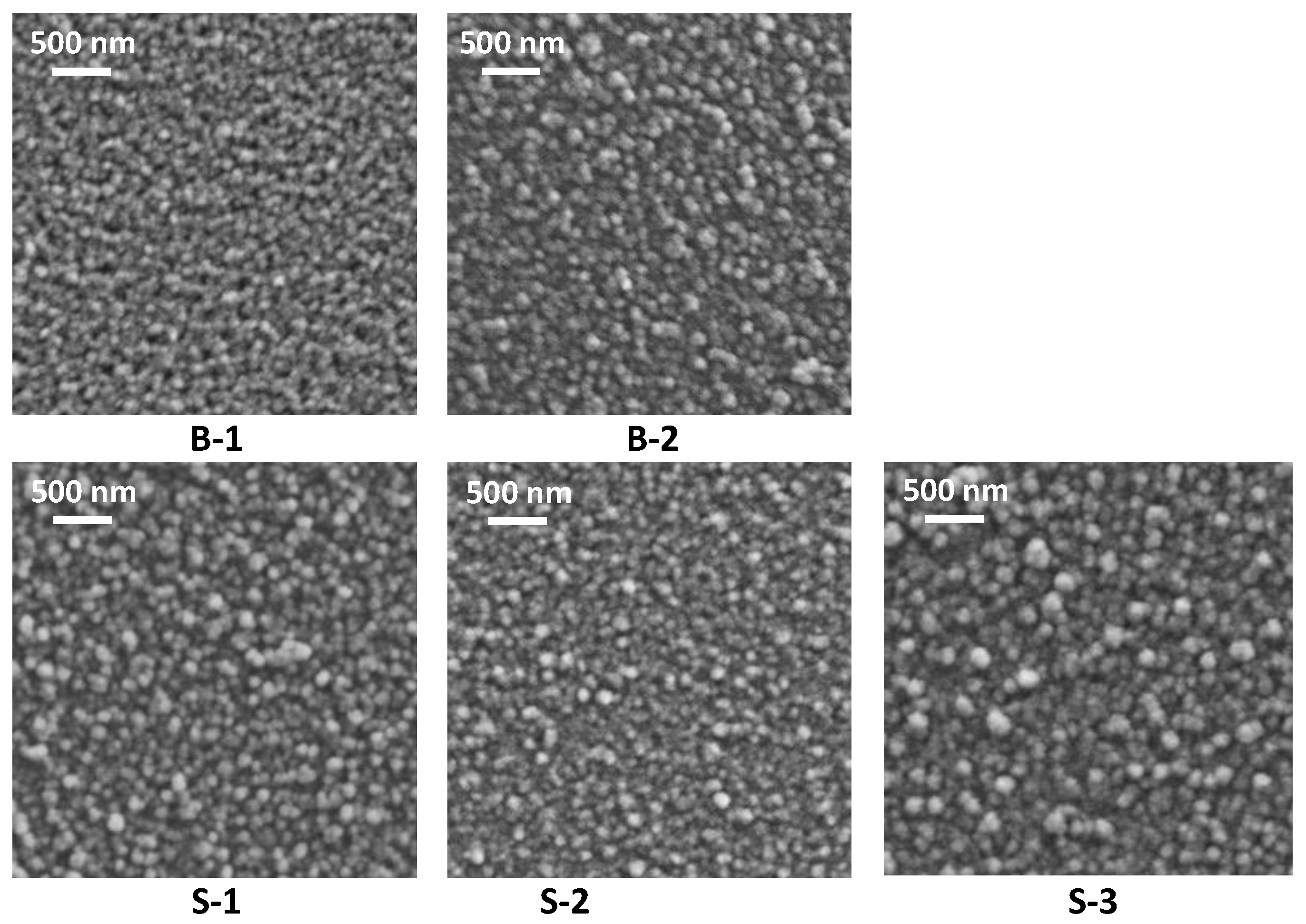
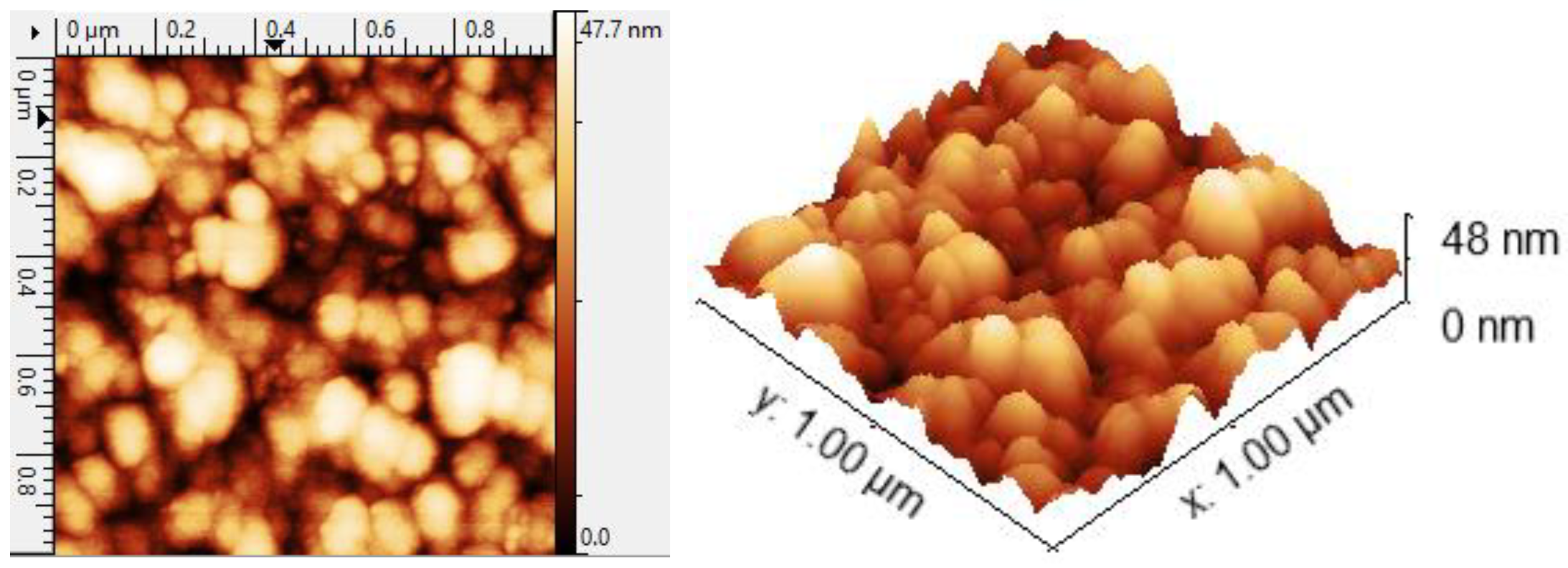

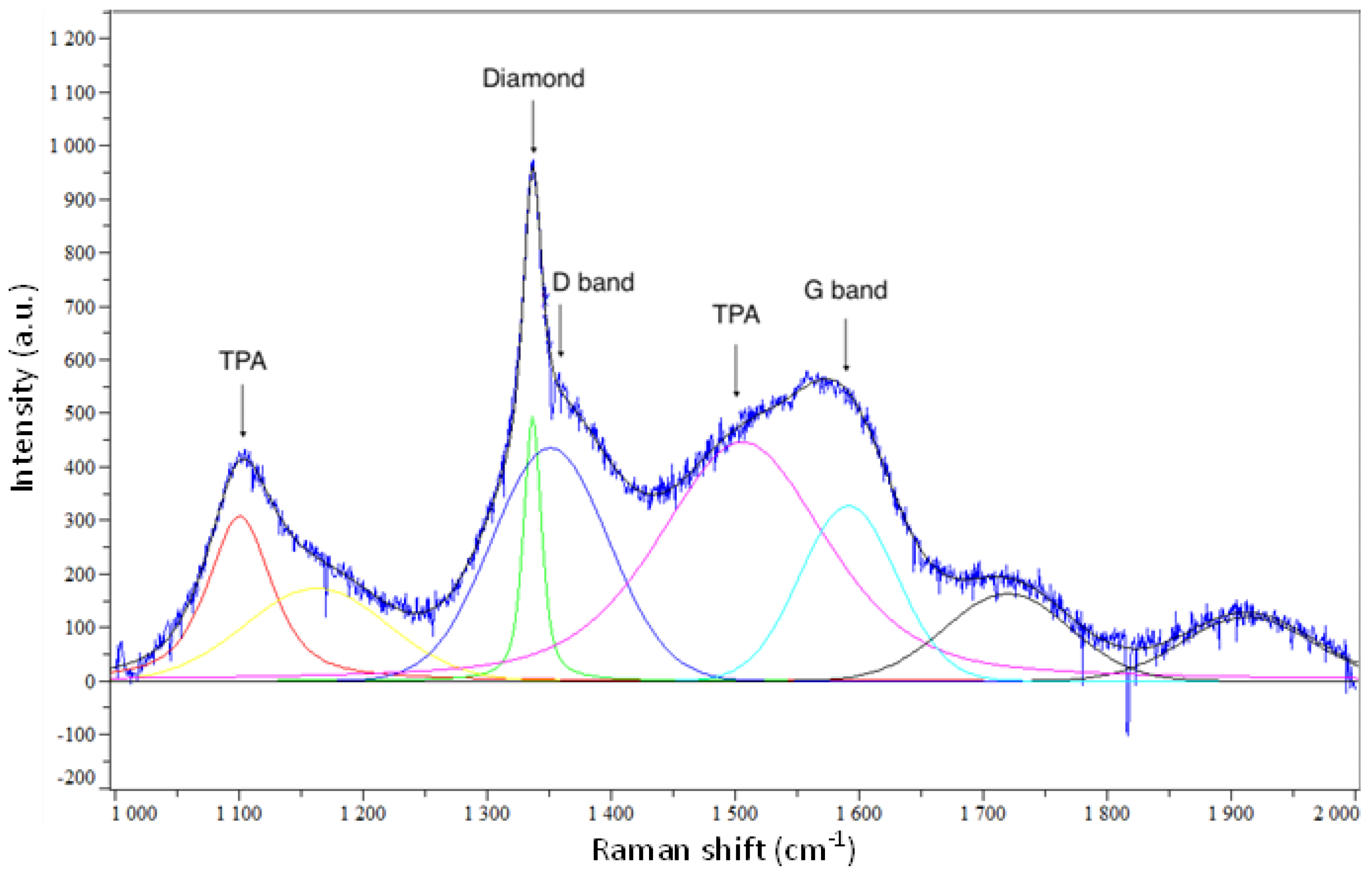

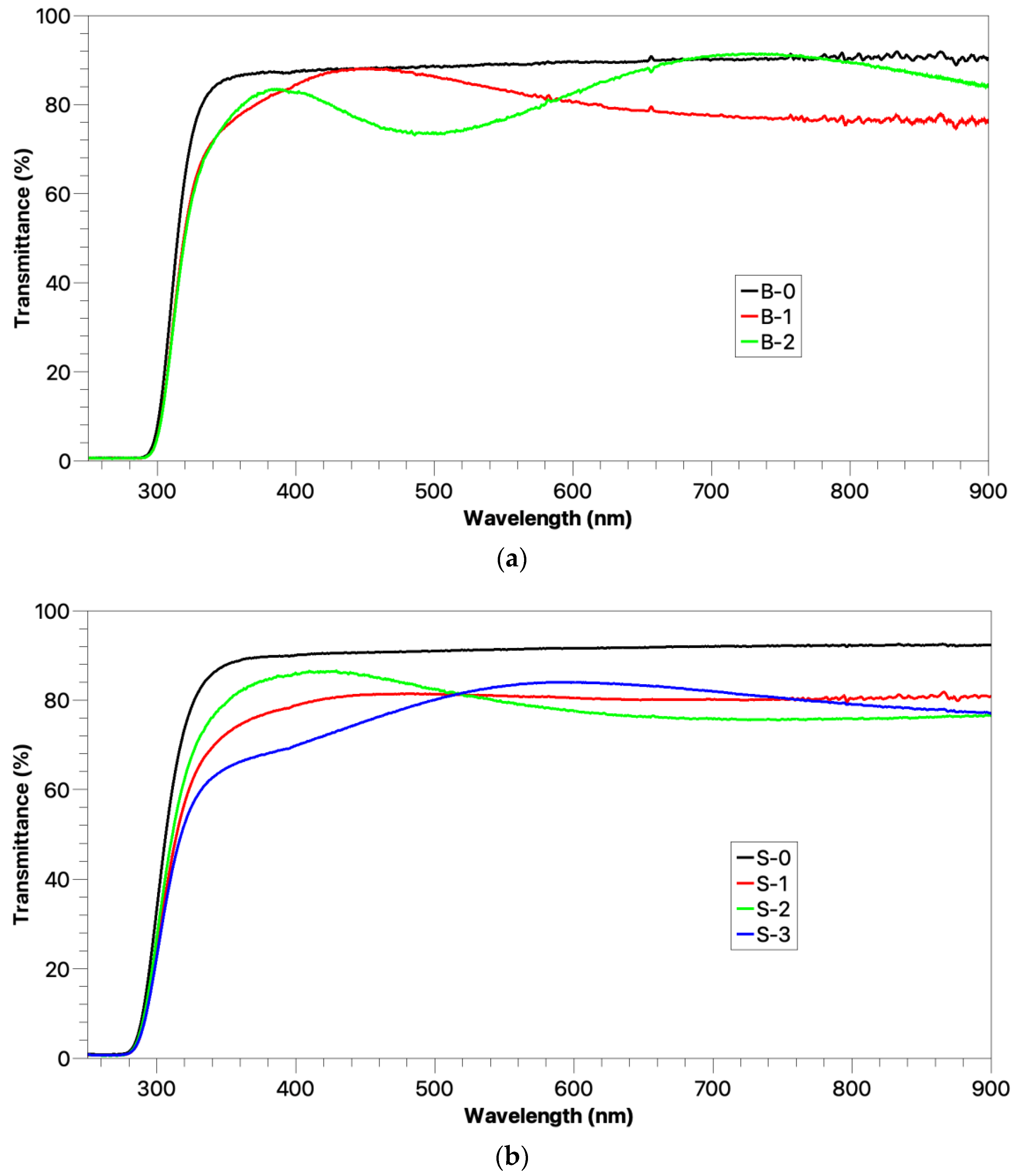
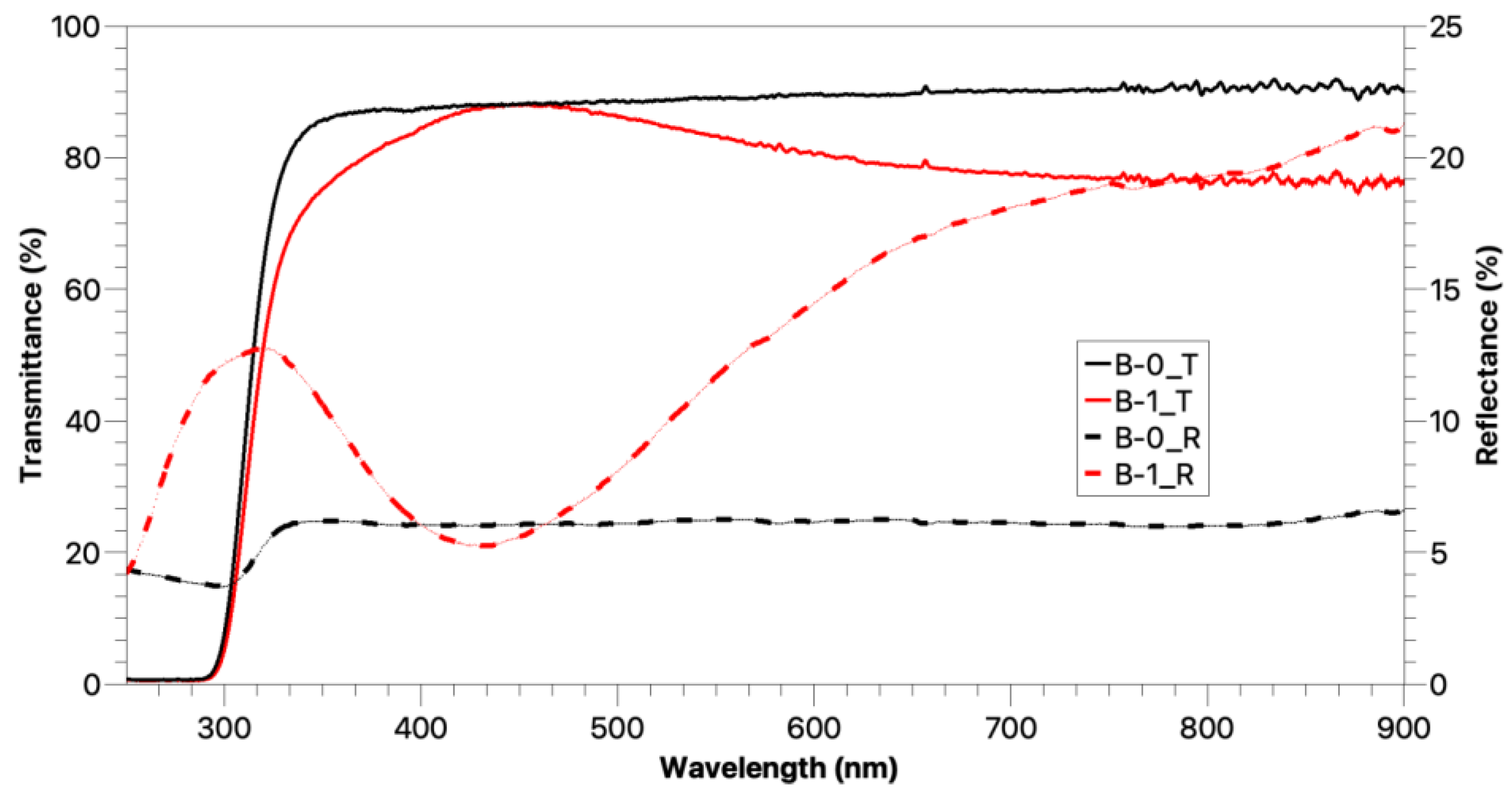
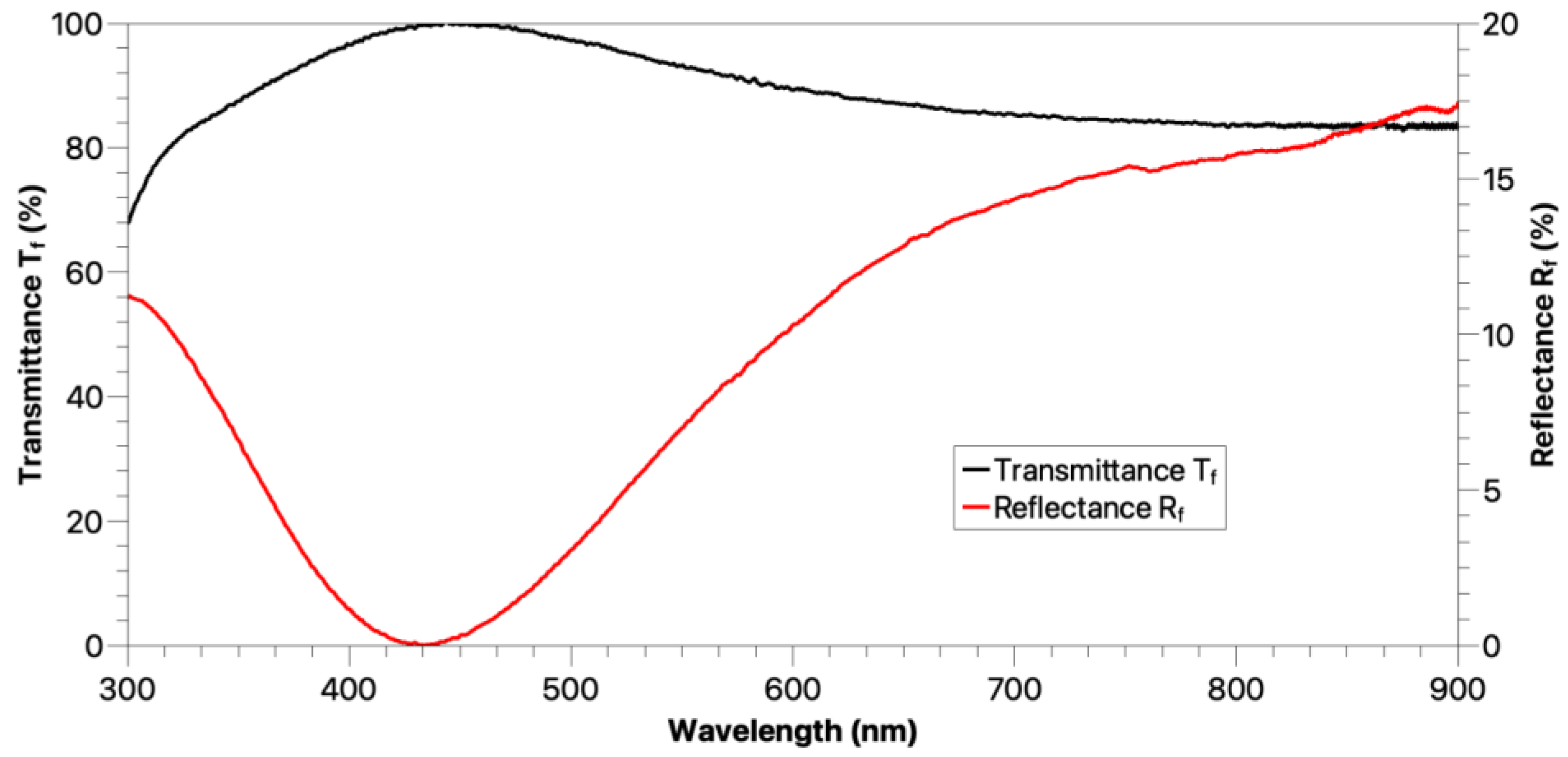
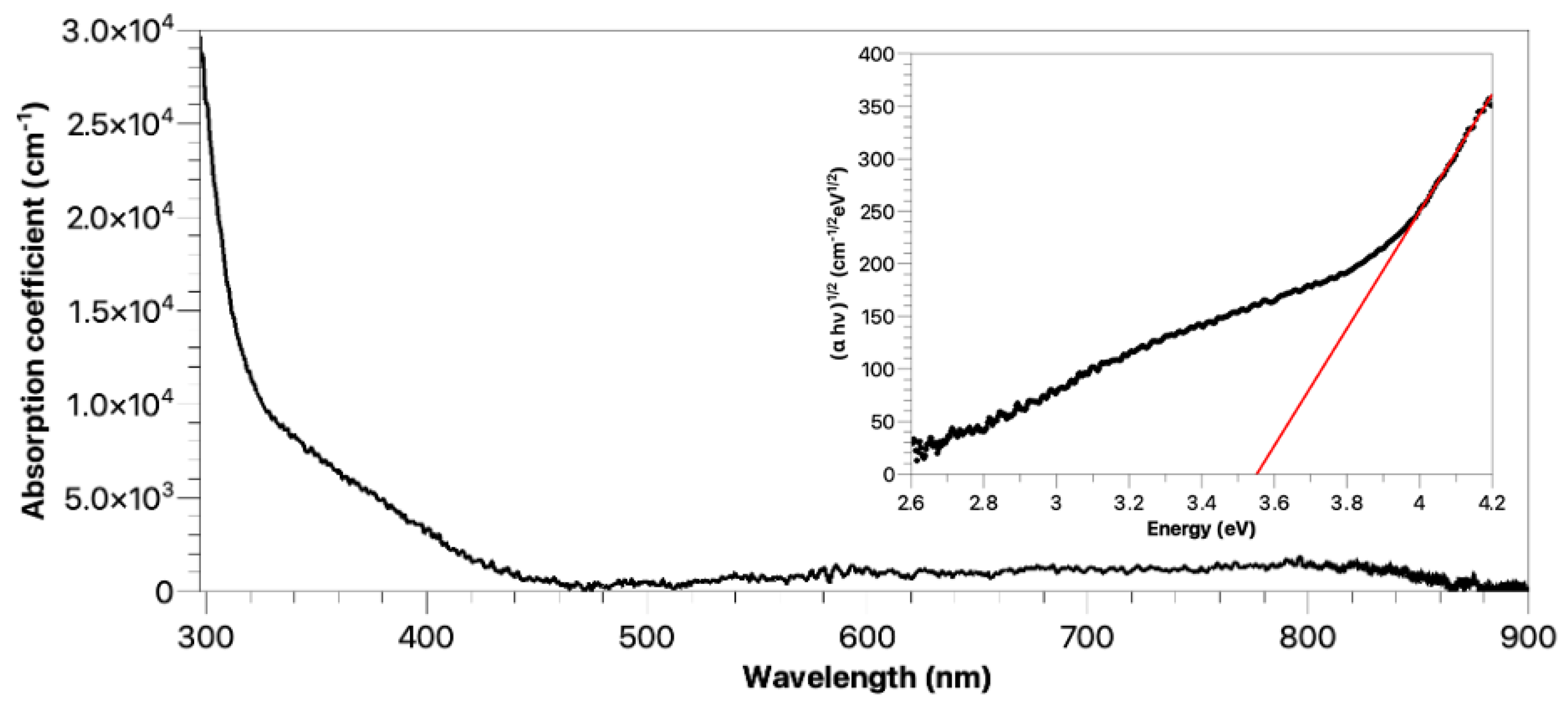
| Sample | Deposition Time (h) | Substrate Temperature (°C) | Thickness (nm) | Growth Rate (nm·h−1) | Rms Roughness (nm) | FWHM (cm−1) | sp3 (%) | Contact Angle (°) |
|---|---|---|---|---|---|---|---|---|
| B-0 | Uncoated substrate | 2.0 + 0.4 | 54.3 ± 2.7 | |||||
| B-1 | 2 | 300 | 95 ± 9 | 48 ± 5 | 6.6 ± 1.3 | 17.5 ± 0.9 | 79 ± 8 | 76.0 ± 3.8 |
| B-2 | 4 | 153 ± 15 | 38.3 ± 4 | 7.4 + 1.5 | 17.8 ± 0.9 | 82 ± 8 | ||
| S-0 | Uncoated substrate | 2.0 ± 0.4 | 40.5 ± 2.0 | |||||
| S-1 | 2 | 265 | 79 ± 8 | 39.5 ± 4 | 4.9 ± 1.0 | 16.8 ± 0.8 | 84 ± 8 | |
| S-2 | 300 | 104 ± 10 | 52 ± 5 | 5.1 ± 1.0 | 17.2 ± 0.9 | 73 ± 7 | 76.5 ± 3.8 | |
| S-3 | 400 | 110 ± 11 | 55 ± 6 | 10.5 ± 2.1 | 17.4 ± 0.9 | 59 ± 6 | ||
Publisher’s Note: MDPI stays neutral with regard to jurisdictional claims in published maps and institutional affiliations. |
© 2022 by the authors. Licensee MDPI, Basel, Switzerland. This article is an open access article distributed under the terms and conditions of the Creative Commons Attribution (CC BY) license (https://creativecommons.org/licenses/by/4.0/).
Share and Cite
Mahi, C.; Brinza, O.; Issaoui, R.; Achard, J.; Bénédic, F. Synthesis of High Quality Transparent Nanocrystalline Diamond Films on Glass Substrates Using a Distributed Antenna Array Microwave System. Coatings 2022, 12, 1375. https://doi.org/10.3390/coatings12101375
Mahi C, Brinza O, Issaoui R, Achard J, Bénédic F. Synthesis of High Quality Transparent Nanocrystalline Diamond Films on Glass Substrates Using a Distributed Antenna Array Microwave System. Coatings. 2022; 12(10):1375. https://doi.org/10.3390/coatings12101375
Chicago/Turabian StyleMahi, Chaimaa, Ovidiu Brinza, Riadh Issaoui, Jocelyn Achard, and Fabien Bénédic. 2022. "Synthesis of High Quality Transparent Nanocrystalline Diamond Films on Glass Substrates Using a Distributed Antenna Array Microwave System" Coatings 12, no. 10: 1375. https://doi.org/10.3390/coatings12101375
APA StyleMahi, C., Brinza, O., Issaoui, R., Achard, J., & Bénédic, F. (2022). Synthesis of High Quality Transparent Nanocrystalline Diamond Films on Glass Substrates Using a Distributed Antenna Array Microwave System. Coatings, 12(10), 1375. https://doi.org/10.3390/coatings12101375






